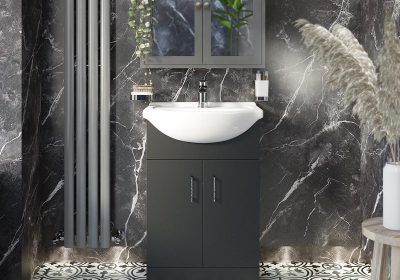Are you dreading calling the plumber to unclog your toilet? We have all been there! It can be an embarrassing situation and nobody wants to have a stranger in their homes for at least an hour digging heavy machinery and making a major mess. Now, you don’t have to go through the embarrassment and hassle – you can unblock your toilet in minutes with a drain snake!
Before you get started, however, it’s important to know the basics of how to use a drain snake properly. Without transferring your plumbing woes onto someone else, we’ve made a quick guide on how to unblock your toilet with a drain snake in no time!
Quick Explanation
To unblock a toilet with a drain snake, you’ll need to insert the snake into the toilet drain and slowly feed it in while cranking the handle. You may need to move the snake around different areas of the pipe until you free up the clog.
What is a Drain Snake Used for?
A drain snake, also known as a plumbing snake or an auger, is a flexible metal tool designed to remove blockages from pipes. The drain snake is usually made of a coil of stiff wire that has an attached handle and crank system to retract the wire and dislodge whatever is blocking the pipe. The snake works by digging through obstructions such as food build-up, soap residue, and debris. Drain snakes are often used when more traditional methods such as plungers and drain cleaners are not effective in unblocking the pipe.
The effectiveness of a drain snake varies greatly depending on the type of blockage and the size of the pipe. For instance, a drain snake will work better for large blockages rather than small ones. Additionally, it is most effective against hard-packed objects like tree roots that may be blocking the line, something that other methods may not be as successful at. That being said, there are a variety of tools available to unblock your toilet; however, it is important to remember that a drain snake should only be used if other methods have already proven unsuccessful.
In conclusion, while a drain snake may not be suitable for every situation, it can prove to be an effective tool when trying to unblock toilets. Even so, it is important to weigh all the options before deciding on which method of clearing the obstruction works best for you. With that in mind, let’s move on to preparing your bathroom and gathering the necessary supplies before using a drain snake on a toilet.
Preparing to Use a Drain Snake on a Toilet
Now that we comprehend what a drain snake is and why it’s a beneficial tool to have, it’s important to know the necessary steps when preparing to use one. When unblocking a toilet with a drain snake, you’ll need to make sure the area is well prepped before you get started. Begin by putting on protective rubber gloves and clearing away any clutter around the toilet. Typically this includes things like rugs, towels or anything else that may get in your way when attempting this project. Additionally, if you have not done so already you’ll want to put down newspaper or a plastic tarpaulin to catch any possible residue that may come out of the drain.
Next, you will want to examine the unexpected external factors that may be causing the clog. Typically this includes checking for items like foreign objects, hairballs, diapers or wipes stuck on the sides of the pipe or other blockages due to soap scum build up around the rim of the bowl. If any of these scenarios apply, then you must take appropriate steps to remove those items before using a drain snake – otherwise they will remain unchanged and their presence could worsen your existing drainage issue.
Finally, prepare yourself for using a drain snake by familiarizing yourself with its specs and instructions for use. It’s best to weigh up different options when it comes to choosing which type of model suits your needs better; as no two models are exactly alike. Make sure do read the user manuals thoroughly before proceeding with any kind of maintenance. Doing so ensures that you avoid any potential harm due to improper usage or overcrowding of the pipe as it requires a precise insertion angle in order for it work effectively and efficiently.
Achieving success when using drain snakes depends heavily on your preparation skills and knowledge about plumbing systems; both are essential elements when optimizing the functionality of the device before use. Having followed all these instructions beforehand now paves our way towards completing our task with ease so let’s move onto collecting required materials and tools for unblocking your toilet with a drain snake in minutes!
- According to plumbing experts, using a drain snake can be up to 98% successful in unblocking toilets.
- Generally, any blockages that are near the opening of the pipe can be cleared by using a drain snake.
- Many studies have shown that using a drain snake for clearing toilets is an efficient and cost-effective method compared to other options such as chemical products.
Required Tools and Materials
Before unclogging a toilet with a drain snake, the right tools and materials must be used. Among these are protective equipment such as gloves and goggles; attempting to unblock a toilet without the use of proper protection is not advised. Additionally, rubbing alcohol or cleaning solution should be on hand to clean any germs that may have come into contact with the surface during the process.
Aside from the protective equipment, it’s important to use a high-quality drain snake or branch auger that will reach deep into the piping of the toilet and break up any blockage that is getting in the way of draining properly. A good quality auger should be at least one-sixteenth inch thick and made of corrosion-resistant materials. Furthermore, since many clogs can be too strong for a standard auger, power augers may be another option to consider. These powerful devices generally have more torque than manual augers, making them much easier to use in cases where there are stubborn clogs.
Overall, whatever tools and materials are chosen when unblocking a toilet, they should be appropriate for the task at hand and high-quality items that won’t easily break under pressure. Now that all the necessary items have been gathered, it’s time to move onto actually unclogging the toilet using a drain snake.
Unclogging a Toilet Using a Drain Snake
Unclogging a toilet with a drain snake can be a viable solution to avoid calling in an expensive plumber, but it is important to ensure that the job is done properly. There are two primary types of snakes, drum-style and coil-style. Drum style snakes include an internal drum filled with wire cable which automates the length extension as it is pushed further down the pipe. Coil-style snakes require manual extension and retraction of the length of the cable. Users should weigh the pros and cons of each type before deciding on the right tool for their job.
A major consideration when using a drain snake to unclog a toilet is to ensure there is enough access space around the toilet bowl to correctly manoeuvre the snake without damaging any pipes or the toilet itself. If there isn’t sufficient surface space, it may still be possible to access the clogged area from behind or through another route if available. It’s also important to note that a drain snake should not be used where recent plumbing work has been done as there could be a high risk of damaging newer pipes and fixtures. Finally, users should always use caution when attempting this task as it is easy to accidentally puncture a water line or inadvertently damage sewage lines under your house if you misjudge the depth of penetration through one of these routes.
The decision to unclog your toilet with a drain snake requires serious consideration and users should carefully review their options before committing to this course of action. With the right preparation and knowledge, unblocking your toilet using a drain snake can be a quick and easy solution that saves time and money while avoiding potentially costly plumbing disasters. With this in mind, we will now transition into discussing how to correctly insert the snake into the pipe so you can successfully complete this task without incident.
Inserting the Snake into the Pipe
Now that you’ve gathered all the necessary tools, you’re ready to move onto the second step of the unclogging process – inserting the snake into the pipe. Before taking aggressive measures with a drain snake, it is important to be aware of both sides of the argument. On the one hand, many argue that an auger can prove effective in restoring waterflow through a paper that is clogged by debris. The sharp metal tooth on one end of this tool acts as an anchor which can pull any blockages from your pipes while simultaneously clearing and enlarging them. On the other hand, some worry that using a drain snake has its risks as there is always a small possibility that something could be pushed further down your pipes leading to more serious damages.
However, if you do choose to insert your auger into your pipe, make sure to do so with caution and proper safety procedures. As you begin this step of the process, ensure that the auger is securely attached and limit twisting turns when threading it down the pipe. Continuing with slow and gentle movements will maximize your chances of successfully extracting any obstruction with minimal damage to your pipes and plumbing.
Once you feel resistance from running into a blockage, begin gently pushing and pulling until it becomes dislodged from the walls of your drains and comes free from your systems. This may require more force than initially anticipated, but be sure to maintain a balanced pace for preventing any possible breakage or splitting of your pipes. In no time at all, you should have cleared away all visible debris. With this in mind, it’s now time to move onto cleaning what’s still lodged within your pipes – pull out all residual material with firm but slow pulls and pushes until everything comes free.
Pulling Debris from the Pipes
Once the drain snake has been inserted into the pipe, the next step is to pull any debris that is blocking your drain. This step can be tricky as you’ll need a good eye for discerning what is blocking the pipe and what isn’t. If it’s something like a toy or jewellery, learn to recognize the difference between what should and shouldn’t be inside of the pipes and take caution when removing them. However, if it’s something more difficult like a piece of hardened debris, then using force will be required to dislodge it. With a little bit of patience and effort, you should eventually be able to remove whatever it may be that is clogging up your drain.
When deciding whether or not to use force, it’s important to consider both sides of the argument. On one hand, using excessive force can result in damaging your pipes or having the clog break off and become entirely stuck in another part of the pipe system. On the other hand, too little force can result in failing to clear the clog altogether. Evaluating each situation on a case by case basis is key in determining which course of action works best for you in clearing the obstruction. Furthermore, it’s also important to assess available tools – such as pliers – that can assist you in safely removing potential problem-causers from your pipes.
Once all obstructions have been removed from within your pipes, it’s time to move onto properly disposing of those items. This part of the process should not be overlooked as improper disposal can lead to further clogs or even worse – damages to your plumbing system. To ensure an optimal outcome, continue reading for tips that will help facilitate proper clog disposal protocols.
Essential Highlights
The process of clearing a clogged drain requires precision and careful judgment. After inserting the snake in the pipes, debris such as toys and jewellery should be carefully removed. For harder obstruction, using force carefully is necessary but should be avoided if possible. In addition, use appropriate tools to safely remove objects that may be causing blockage. Finally, once obstructions are removed, proper disposal protocols should be followed to avoid further damages or clogs.
Tips for Clog Disposal
When it comes to disposing of the clog that has been removed from your drain, it is important to first consider the type of debris that you have pulled out. If the clog consisted of larger materials, such as toys, then you should always dispose of these items in the trash or recycling bin. They can cause further blockages if returned to the system and should not be flushable. If you are dealing with smaller debris such as hair, soap scum, or food residue, it is safe to return them to the waste pipe system.
While there is a debate in the plumbing community about whether returning debris down the drain is a good practice or not. However, those who support returning debris point out that most plumbing systems are designed to handle some level of build-up within their pipes and therefore can generally handle the return of small amounts of material without any issue. Those who argue against this practice suggest that any debris left behind may cause future blockages and should therefore be eliminated entirely.
Each option comes with its own implications for safety and effectiveness. Ultimately, it will depend on each unique situation as to which solution should be chosen. For example, if a person routinely deals with large clogs or if they have an older home with pipes prone to getting clogged up more easily, then discarding all foreign materials may be a wise choice. On the other hand, if someone lives in a low-traffic area or their plumbing system regularly remains clear, then returning small amounts of debris down the waste pipe may be preferable.
No matter what method you chose for disposing of your clog material, it is advisable to take steps towards minimizing future blockages in your pipes wherever possible. This might include activities like preventing food scraps from entering your sink’s drainage system by using a catch bin or regularly practicing preventative measures such as pour vinegar down your drains once a month. Taking preventive measures now can help avoid costly problems later down the line.
FAQ
What do I do if the drain snake doesn’t work to unblock a toilet?
If the drain snake doesn’t work to unblock the toilet, your best bet is to call a plumber. Although drain snakes are effective for most clogged toilets, sometimes more specialized equipment and know-how is necessary. A licensed plumber will have the appropriate tools and experience needed to identify the cause of your clogged toilet and complete any necessary repairs. Additionally, if you rent or own a home, it may be possible to claim some of the cost from your insurance coverage, so it is always worth double checking this first.
Are there any safety considerations when using a drain snake to unblock a toilet?
Yes, there are a few safety considerations when using a drain snake to unblock a toilet. Make sure you keep the snake far away from your face and eyes, as it can splash back filth or bacteria while being used. Wear protective gloves when handling the snake due to bacteria and dirt that could be present. Additionally, ensure that you are using an appropriate sized drain snake for the size of pipe in your toilet. If not, the snake can cause damage to the pipe itself.
What is the process for using a drain snake to unblock a toilet?
Using a drain snake to unblock a toilet is a relatively straightforward process. First, you should remove the lid from the tank and place it somewhere out of the way so that you can access the fill valve. Next, you need to locate the clog in the toilet’s pipe. This is usually found near the bottom of the toilet.
Once you have located the clog, you need to insert the end of a drain snake into the pipe. Gently push it through until it reaches the obstruction – sometimes this may take several minutes. Once it has reached the blockage, start twisting it in a clockwise direction in order to break through it. Once you have broken through, slowly pull out the snake while continuing to twist – this should help dislodge and clear away any debris.
Finally, after removing as much debris as possible with your drain snake, flush your toilet and check if it is now unblocked. If necessary, repeat the process until there are no further blockages present. With regular maintenance and use of a drain snake, you should be able to keep your toilet free flowing and free from clogs.



